Having flirted with relegation from the WSL for a number of seasons, 2020/21 saw Bristol City Women’s luck finally run out, with them slipping through the trapdoor and bringing their five-year stay in the top tier to an end. Whilst fans would have hoped for an immediate return, the simple fact that the team needed a new interim head coach to replace Matt Beard, who had departed to take over at Liverpool Women, with Tanya Oxtoby still on maternity leave, and had seen 19 or so players depart for pastures new meant that the chances of doing so were very slim.
Instead, when former assistant coach Lauren Smith was handed the reigns in the summer, her task appeared to be more rebuilding the squad and implementing a style of play that would produce exciting football than achieving immediate promotion, with results not expected initially due to the amount of development and change that was required.
Nevertheless, it quickly became clear that Smith was the right person to lead the team, and, when Oxtoby announced her permanent departure a few months later, the Welsh coach was handed a permanent three-year deal. It was a sign of faith in her plans for the team, and, fast forward to now, that faith has been repaid, with Smith leading the club to the Women’s Championship title and promotion back to the WSL at the second time of asking.
The way that she has achieved that feat has led to plenty of plaudits both from inside and outside the club, with many noting how she has transformed the team’s tactical identity and given them greater freedom on the field than they had previously enjoyed, whilst her recruitment has been smart and has been key to her getting her ideas across. This tactical analysis will look at both of those in turn, first making comparisons between the team that came down and the one going back up and then highlighting some of the players who have contributed to their success.
2020/21 relegation
When Bristol City Women’s relegation was secured, there were a great many reasons that were picked out to blame for it, with some suggesting a lack of club backing and others noting how young and inexperienced the squad was. However, one thing was clear, and that was that, despite Bristol’s best efforts to stay in the division, they had simply not been able to attain the points on the field required to maintain their place in the league.

As a result, it seems prudent to examine why that was the case, and one thing that immediately stood out when watching them was their “defend first” mentality under Beard’s management. More often than not, they tended to set up in either a 4-1-4-1 or 5-4-1 formation under him, with each being used on 32% and 22% of occasions respectively, and it was clear that his aim was first and foremost to not concede.
That is not to say that he and Bristol didn’t value goals though, because their game plan did revolve around counterattacking as soon as they won the ball. It was just that that was not their first priority.
As a result, their tactics revolved around a lot of long balls towards the lone striker, more often than not England international Ebony Salmon. However, this was a risky way of playing, not only because it relied on Salmon having an end product but also because she was often on her own at the top of the field and there was a very real risk of her being outnumbered.
On many occasions, she did manage to outrun her opponents, as she is here with Aston Villa Women’s Natalie Haigh and Elisha N’Dow, but the fact that she only scored six times in the WSL that season showed that Bristol were relying on a style of play that wasn’t producing results.
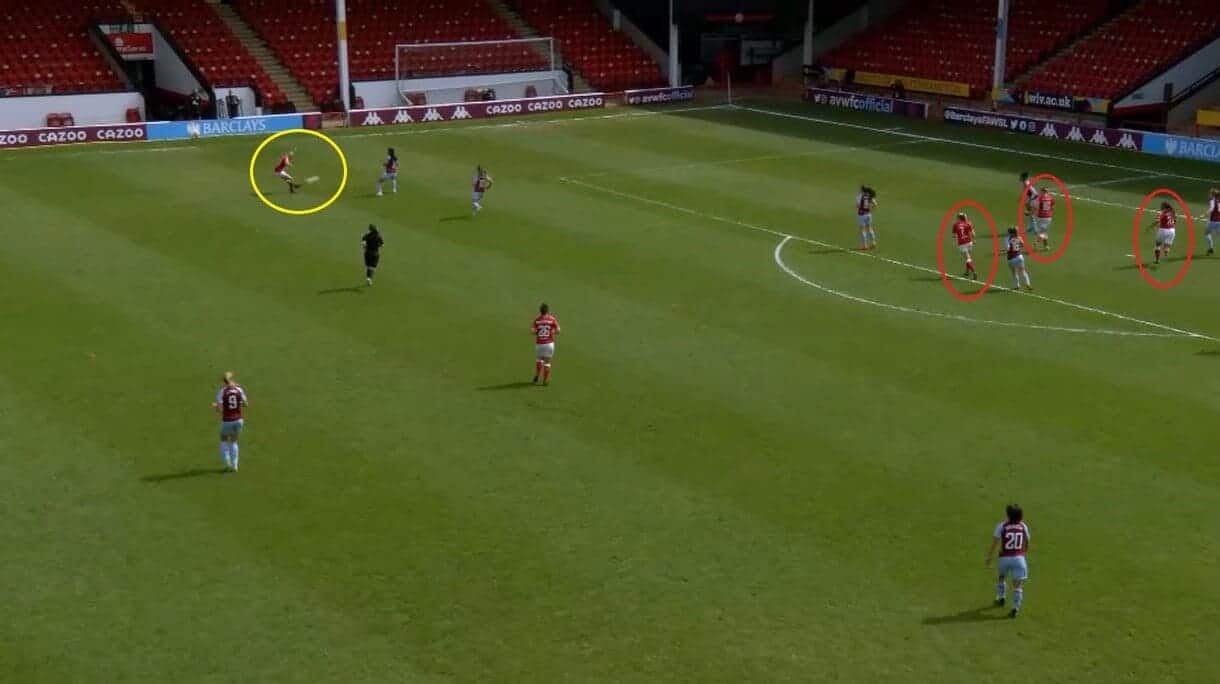
They didn’t play that way all the time though, with Beard recognising that some games were there for the taking and his side needed to take the initiative and play more on the front foot. The game against Aston Villa was one of those, and, to his credit, Beard did give his players as much freedom as possible to push up the field and take the game to their opponents in order to have as strong a chance as possible of returning home with three crucial points.
However, despite that, Bristol had other problems, such as poor execution when they did get into promising positions. On this occasion, left-back Jemma Purfield has sent a well-aimed cross into the goal area and has four players in a position to meet it and turn it towards goal, but neither Molly Pike, Yana Daniëls, Abi Harrison nor Carla Humphrey moved towards it and the ball instead bounced harmlessly behind for a goal kick.
The fact that Bristol as a team only averaged 0.82 goals per game in 2020/21 is not surprising when looking at wasted chances like this, and it’s not hard to see why they were at the foot of the table and why they eventually went down.
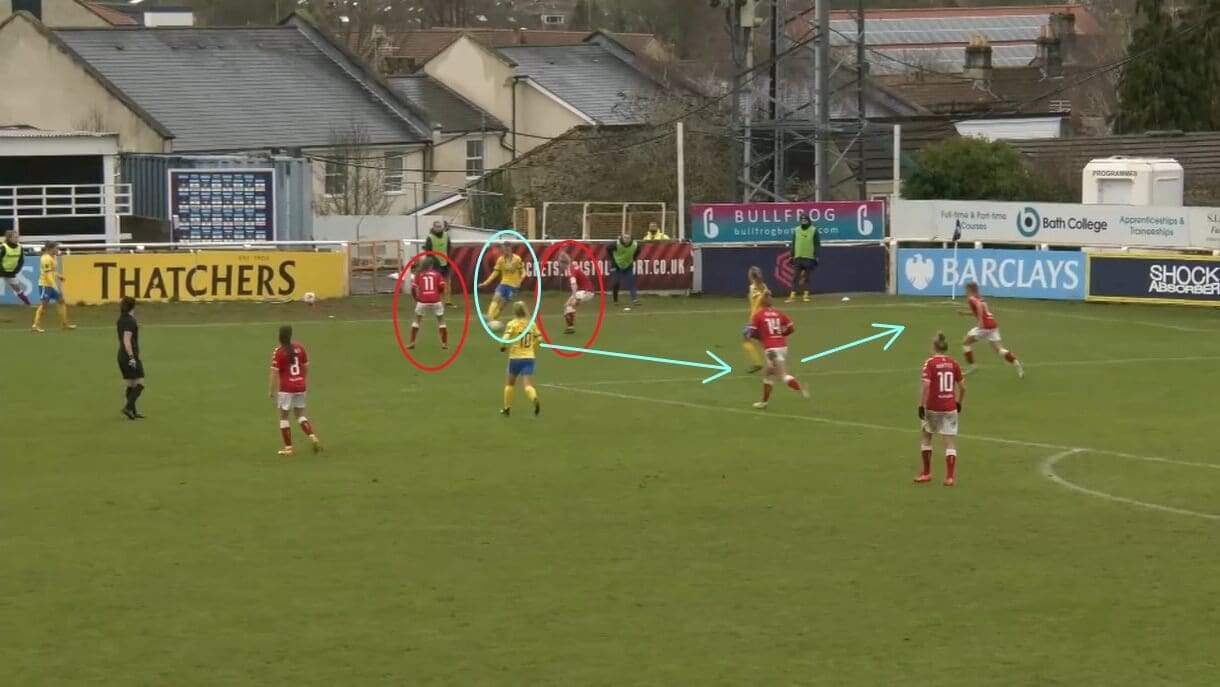
That poor quality was also evident in Bristol’s defensive play that season, with the team often too passive and making it far too easy for their opponents to create chances inside their own third. Here, Brighton and Hove Albion Women’s Ellie Brazil (now at Tottenham Hotspur Women) has been able to construct a one-two and receive the ball in the space behind the Bristol players without being challenged by any opponent.
Whether it was due to players being unsure of whether to press or to hold their ground or whether they simply lacked motivation, these were the moments when Bristol really looked like a team heading out of the top flight.
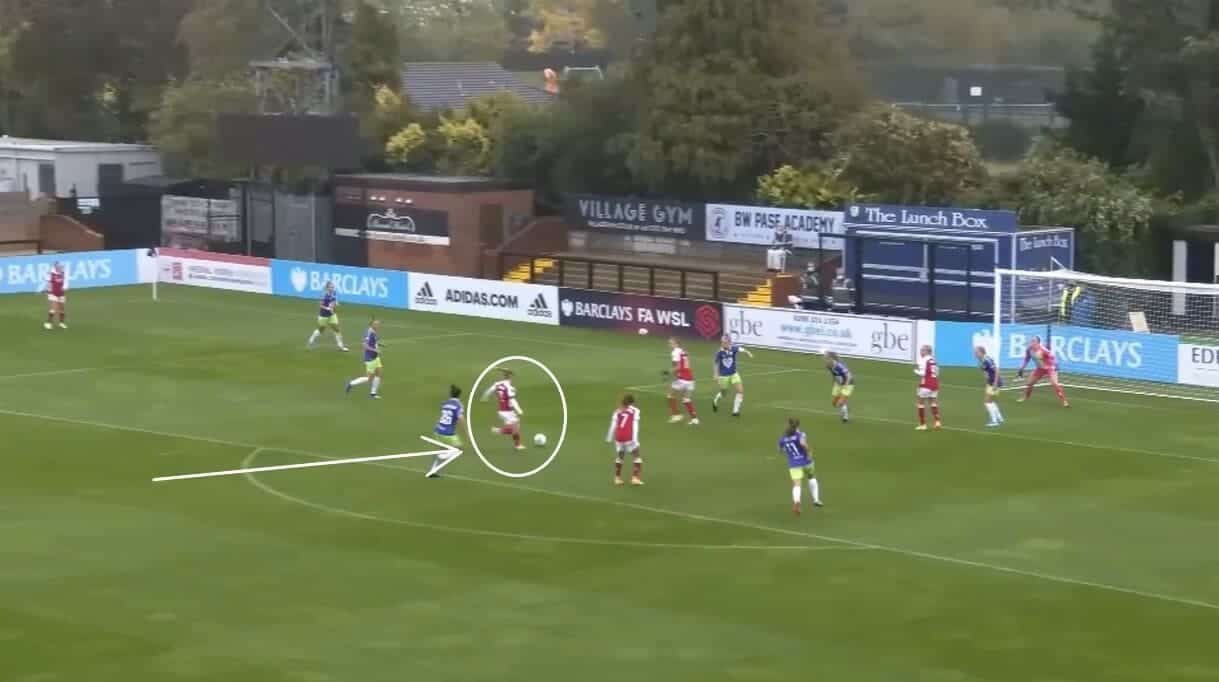
Even in the few games where they were clearly up for the fight, they were let down by poor moments of quality, and they will have frustrated the fans and those watching on the sidelines. In this game, the pressure was off, with Arsenal Women expected to win the match, and so all they needed to do was to sit back in a low block and be solid without the ball and they would have a chance of taking a well-earned point.
However, they ended up leaving too much space open between their lines and making it easy for Arsenal to play the ball between them, which was always going to lead to goals being conceded. Here, England midfielder Jordan Nobbs has run onto a pass from Australia forward Caitlin Foord and fired past Bristol goalkeeper Sophie Baggaley, and it really was that easy to break Bristol down at times.
Attacking changes
With all of that in mind, it was clear that whoever came in to replace Beard would have a big job on their hands, with the club recognising the need for a major reset and the players requiring a coach whose tactics would yield positive results.
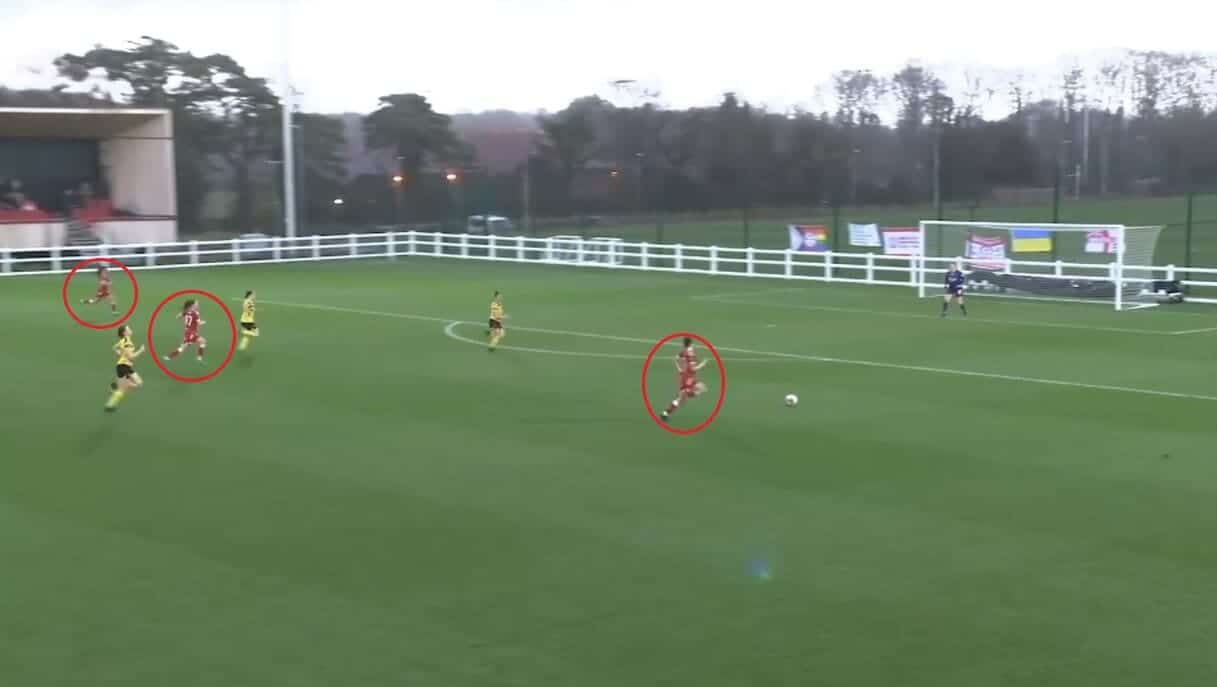
Smith clearly got that message, and, as a result, she didn’t overload her players with too much information at once and instead drip-fed her ideas in order to make gradual improvements. For that reason, a lot of Bristol City Women’s early play in the Championship was very similar to the previous campaign, with them tending to play counterattacking football that once again relied on them getting behind opposing defences before they had had a chance to set their defensive shape up.
However, it was also clear that Smith had been tweaking the way that her side approached these situations, with them no longer playing long, direct passes and instead keeping the ball on the ground and dribbling it up the field. This then allowed more players to get into advanced areas, creating situations like this one, against Watford Women, when Bristol had three players in forward areas and were able to pose a greater threat than the campaign before.
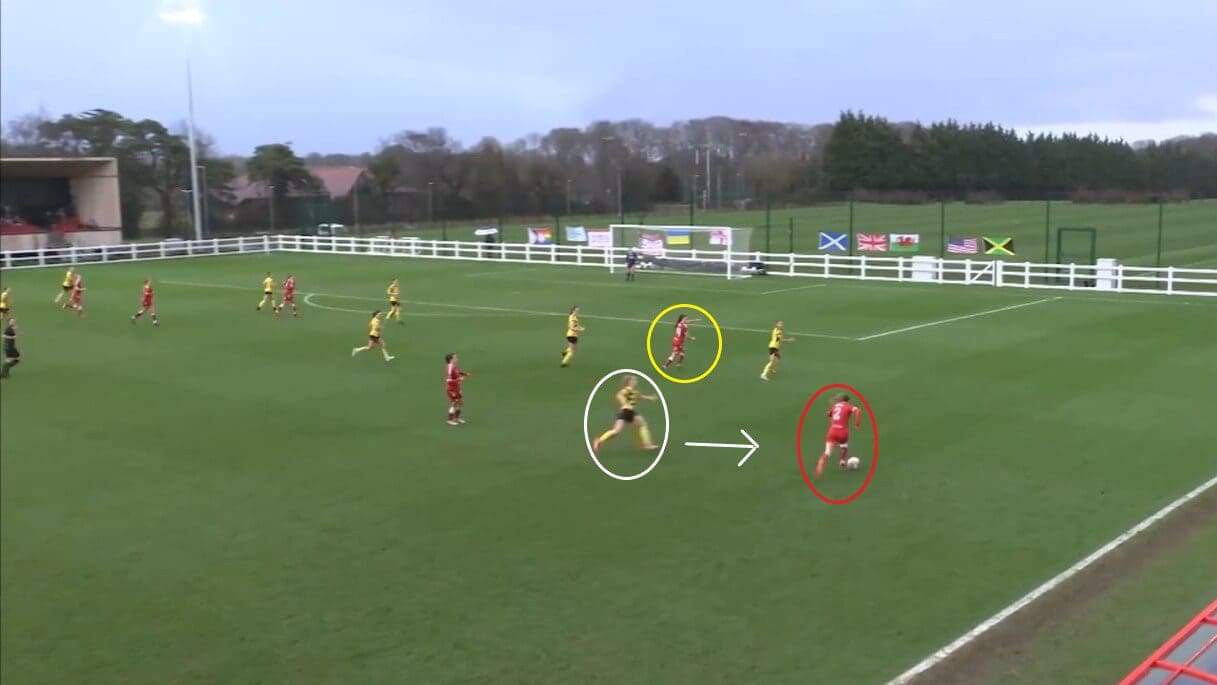
Having wide forwards in advanced areas really helped the rest of the team too, with the full-backs benefitting especially from their presence as they could now link up with those players in order to manipulate opposing defences more.
As such, situations like this became more prevalent in their play, with Wales right-back Ella Powell, who was one of Smith’s many signings during that summer, using fellow Welsh international Ffion Morgan to create a gap in the Watford ranks, with Watford recognising that Bristol now have a numerical advantage and therefore moving Flo Fyfe (in the white circle) across to nullify that problem. However, in doing so, they have opened space up on the inside for Bristol to exploit, which Powell instantly takes advantage of.
Therefore, whilst both Beard and Oxtoby had championed the idea of playing with attacking full-backs, Smith took it further and ensured that they offered a direct threat to their opponents, again showing how the team were playing with the same ideas as before but with Smith’s personal touches also evident.

As Smith’s tenure has gone on, however, there have been more signs of her ideas taking over and the old Bristol being phased out. One of the key things that has changed in that regard is the team’s dependency on progressing the ball through the middle of the field rather than relying on the full-backs, meaning that sequences of passes like this have become increasingly common.
The reason that Smith has introduced this idea during her second season is because the first was spent working on basic principles of play and making sure that her team were scoring goals, being tough to beat and ultimately winning games, all ensuring that confidence was restored on the pitch. With them finishing that campaign in third place, it then became about making the next steps to continue their development, and moving towards a more pass-centric style was one of the things that she turned to.
This new style has caught more opponents out than before, with Bristol working hard on getting the detail of these patterns of play right and ensuring that they can execute them to perfection, and the fact that the ball travelled from defender Vicky Bruce to midfielder Aimee Palmer and then to January recruit Rachel Furness with first touches only showed the confidence and belief that the players now have.
Add to that the fact that, two phases after Northern Ireland international Furness moved the ball forwards, midfielder Emily Syme was able to test Blackburn Rovers Ladies goalkeeper Alex Brooks, and it’s clear that this style of play was one of the reasons that Bristol were able to take the next step and seal promotion.
Defensive changes
Bristol City Women’s defensive play has shown the same level of progression under Smith, with them once again starting with the basics and then developing their setup in order to have a better chance of winning games that they might have previously drawn or lost.

Whilst their attacking play did start to show progress almost from the first game, Bristol’s play out of possession took a lot more time to improve, with many of their performances containing the same mistakes that had previously let them down.
Here, they have set up with the same structure as before, in that they have two banks of four trying to put as much distance between the ball and the goal as possible, but have once again left too much space between their lines and allowed their opponents to play through them, with Durham Women midfielder Mollie Lambert finding influential playmaker Beth Hepple, who then set up Kosovo striker Elizabeta Ejupi, in the white circle here, to score.
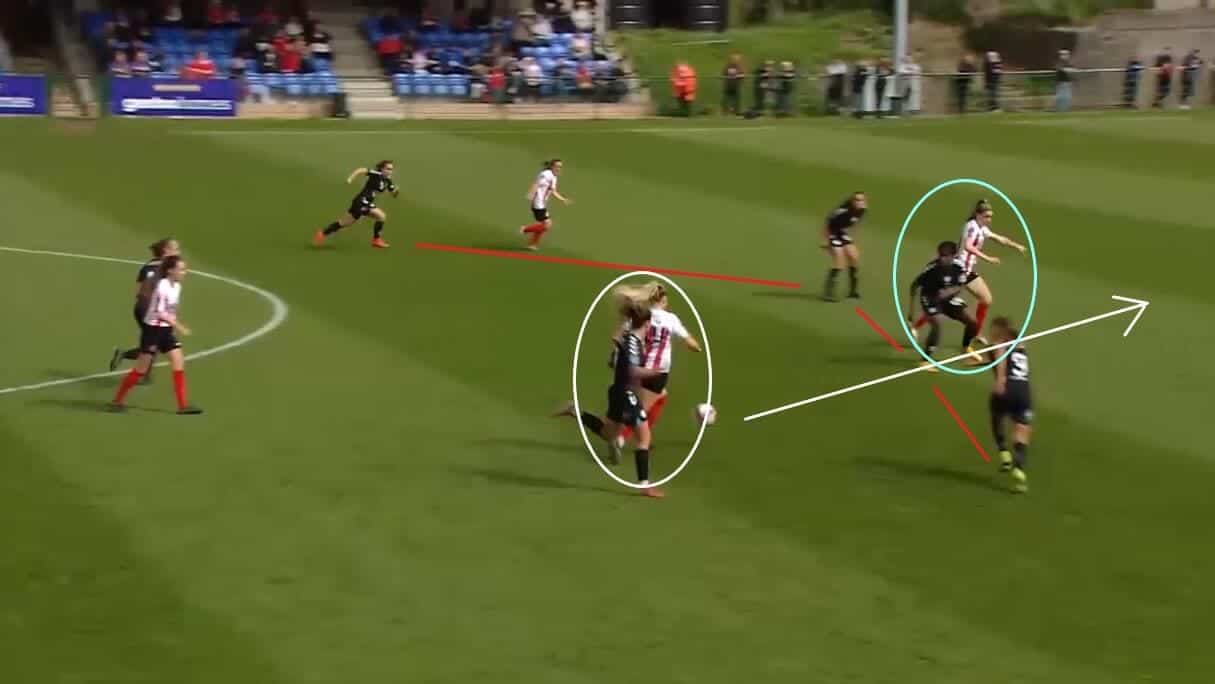
The passivity that so prominent in tighter areas also returned, with Bristol continuing to demonstrate their indecision in these moments and therefore giving their opponents time to play through them, with Sunderland Women forward Emma Kelly finding fellow attacker Emily Scarr with her pass here.
Scarr has shown throughout her time in the Championship, which began when Sunderland were promoted from the Women’s National League two seasons ago, that she cannot be given this amount of time and space with the ball and will punish moments of hesitation, and, even though she missed the target on this occasion, it was a warning that Bristol needed to heed if they were to challenge at the top of the table.

Therefore, it was clear that Smith needed to spend more time improving her side’s play out of possession than she did in it, and witnessing these moments of poor play was perhaps why she opted to appoint former Aston Villa and England defender Anita Asante as the club’s new first-team coach last summer, with Asante retiring from the game at the end of last season. Her defensive knowhow has been credited by players and staff alike for Bristol’s improved fortunes inside their own half this season, with them only conceding 10 goals instead of the 15 that they let in last time out.
However, the other thing that has undoubtedly had an impact is the aforementioned wing-back system, with its benefits to Bristol’s attacking play already pointed out in this scout report, but the defensive side of things has also improved as it has given the team a third centre-back. As a result, players in the back line have been able to defend with more clarity when in 1-v-1 battles, as is the case here with Brooke Aspin needing to limit the threat posed by Southampton midfielder Beth Lumsden.
Last season, with Bristol having two centre-backs in the side, it might have been difficult for Aspin to move across and face Lumsden in this way, with the problem being that it would have left a gap open in the middle for Southampton to play through. Now, though, the added player in the back line has taken that issue away, meaning that the two outside defenders need only focus on the player directly ahead of them, and the fact that Lumsden, who has been one of Southampton’s most creative players this season, was unable to make anything of this opportunity showed just how much of a positive impact the new formation has had on Bristol’s defensive play.
Key additions
It is not all about implementing new tactics though, because the other side of Bristol’s improved form under Smith has come through her recruitment. She effectively had a clean slate with regard to which players she could bring in, with the team having so many spaces to fill before their first season back in the Championship got underway, but that is often when recruitment is at its most difficult, due to coaches needing to find the right players that match their preferred styles of play. However, as with everything that Smith has done so far at the club, she got the key decisions right.
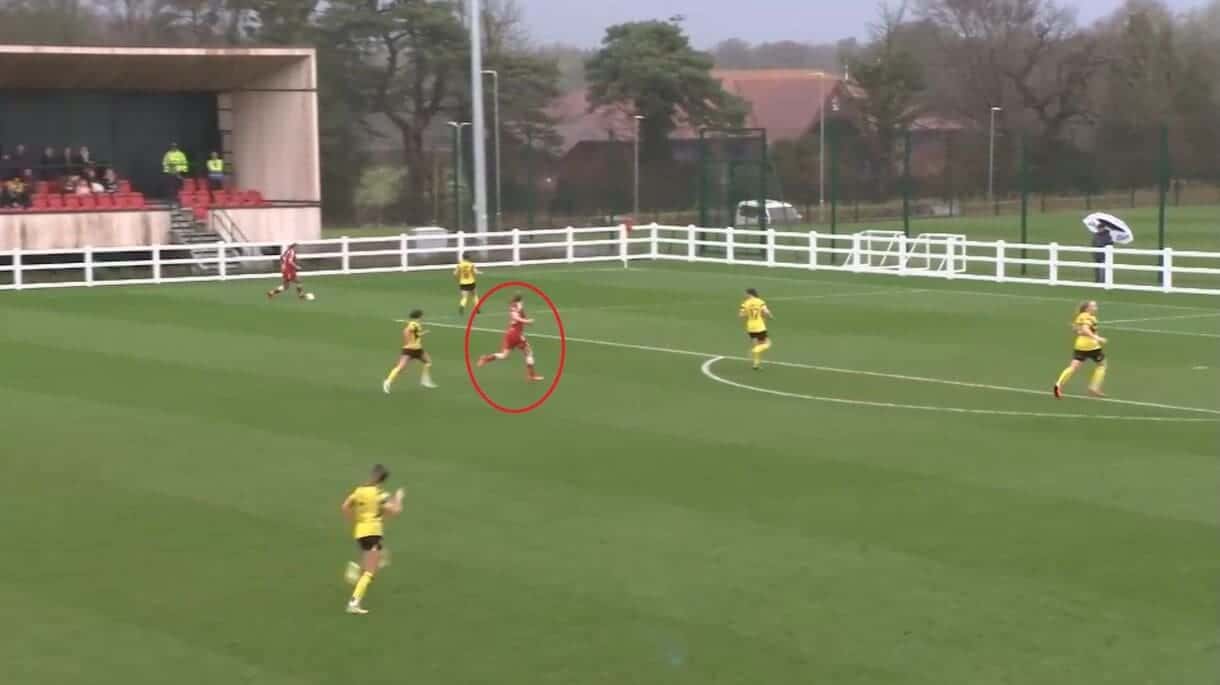
As with her decision to slowly introduce the new style of play, Smith opted not to look for specific profiles in her first summer transfer window and to instead focus on players who had the basic qualities needed to perform on the field, such as pace, spatial awareness and desire, and who would also be able to cover a few different positions in order to afford her the option to change things around if needed.
One of those who provided her with all of those things was Chelsea Women prospect Aggie Beever-Jones, who tends to play as a wide forward but who has a good level of creativity and likes to get on the ball and make things happen.

As this graphic indicates, Beever-Jones covered a lot of ground during her season at Bristol, with it not uncommon to see her moving into central areas, as she was in the previous image against Watford, as well as staying in the wide channels. Her importance to Bristol’s attacking play increased as the season went on, with her linking up with players all over the pitch and really showing what she could do when given the ball.
Again, her arrival highlighted how Smith’s priority at the start of her reign was not on changing too much at once, with her wanting to address tactical issues and defensive errors first before implementing her own shape, and that was why she looked for players who could positionally rotate and play in different roles last season.

Last summer saw Smith’s transfer business become more focused however, with her looking for specific players who could fit into the wing-back system that she was looking to implement. On the right, she already had Powell as a wing-back option, but didn’t have anyone on the left who could offer the same level of attacking and defensive quality required.
As a result, the departure of Jodie Hutton from Aston Villa came at the perfect time for her, with Hutton demonstrating at her previous club that she had the speed needed to move up and down the field as required, and Smith therefore saw her as the perfect fit. As the campaign has gone on, Hutton has undoubtedly lived up to expectations, with her working hard in both halves and helping to both stretch opposing defences out, as is happening here against Blackburn, and to deliver accurate balls into the middle, and there is little doubt among Bristol fans that she has been a key reason for their success this season.
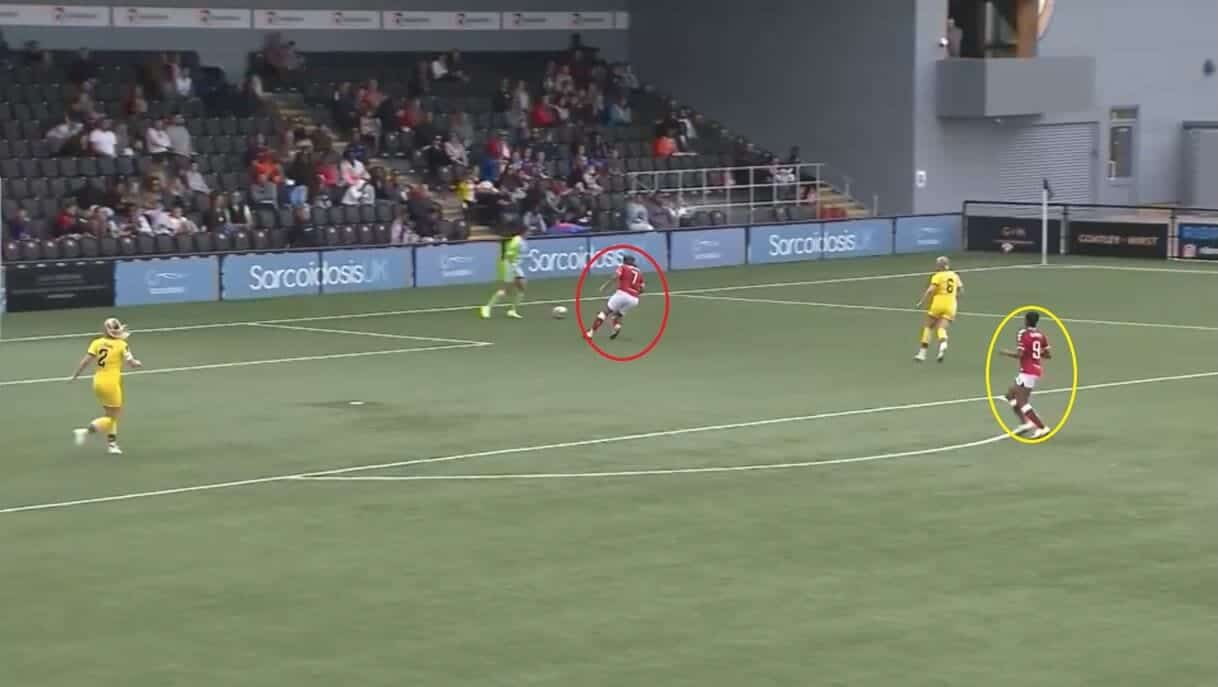
One player who was already at the club and who Smith had earmarked for a leading role in her side was Scotland striker Abi Harrison, with her being tasked with staying in advanced areas and providing the end product that rewarded the efforts of the rest of the team during their build-up play.
However, what Smith also recognised was that whoever played at the top of the field would need support from another striker, and so she went out and signed Melissa Johnson in her first summer. With Johnson being as prolific in front of goal as Harrison can be, it was clear that this was a move again designed to allow rotation at the top of the field, as is happening here against Crystal Palace Women, in order to help the team score more goals and get their attacking confidence back.
When Johnson left this summer for Charlton Athletic Women, Smith swooped for another former Aston Villa player in Jamaica striker Shania Hayles, and she has arguably added even more of an attacking threat due to her being this season’s joint top scorer in the Championship.
For her previous club, she could at times play as one of their wide forwards and scored from the half-spaces, and was capable of cutting inside or staying in slightly wider areas, so Smith evidently saw her as another perfect fit for her wing-back setup, showing again how her recruitment was about versatility in the first summer and then filling specific profiles in the second.
Conclusion
In conclusion, this tactical analysis has looked at Bristol City Women’s promotion to the WSL after two seasons in the Women’s Championship, highlighting the tactical differences between the team that came down and the team that is going back up and how clever recruitment by head coach Lauren Smith has been central to their success.
As the analysis has shown, a lot of what Bristol have done well has been down to Smith going about changing things carefully, with her not wanting to make too many alterations at once and instead introducing new concepts when she felt that her players were ready to embrace them, and that is why they have been labelled by some as “a team steadily rebuilding”. This way of working has led to some poor results at times as the players have got used to each new element, and therefore patience both in the stands and in the boardroom has been needed, but both have stuck by her so far and could see what she was trying to do, and, as mentioned, they have now been rewarded for continually backing her.
If Bristol are to stay in the WSL, then this summer will be vital for them. Off the field, big decisions have already been made, with the news recently coming out that Ashton Gate will become the women’s team’s permanent home venue next season (they had been playing at the Robins High Performance Centre this season). On the field, recruitment will be vital to their chances of staying up, especially if the top flight is as tight at the bottom as it has been this time around.
Again, Smith will need to be smart about who she brings in, with each new signing needing to add something to the squad, and the board have already promised the necessary backing to enable her to add what she feels is necessary. With a style of play now fully established, it is likely to be a window not unlike last summer, with Smith focusing on filling specific profiles and adding depth to an already talented squad, whilst also replacing some key loan signings such as defender Gracie Pearse and creative midfielder Grace Clinton (whose parent clubs are Tottenham and Manchester United Women respectively).
With just one league game left for them to navigate, which sees them travel to St. Andrews for a tricky tie against in-form Birmingham City Women on Sunday afternoon, Smith and her players can afford themselves a smile at what they have accomplished this season. However, they will also know that the hard work starts now, and preparations for their return to the WSL will no doubt be already underway.





Comments